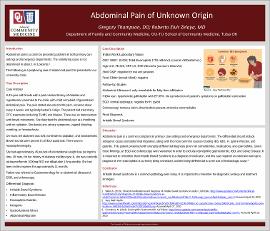| dc.description.abstract | INTRODUCTION: Abdominal pain is a common presenting problem in both primary care settings and Emergency Departments. The underlying cause is not determined in about 1 in 3 patients. The following is a perplexing case of abdominal pain that presented to our University clinic.
CASE DESCRIPTION: A 43-year-old female with a past medical history of diabetes and hypertension presented to the clinic with a chief complaint of generalized abdominal pain. The pain started about 6 months prior and occurred about every 4 weeks, and typically lasting for 3-4 days. The patient had tried many over-the-counter treatments including TUMS and Maalox. There was an improvement with bowel movements. She described the abdominal pain as a throbbing with no radiation. She denied any urinary symptoms, vaginal bleeding, vomiting, or hematochezia. She had approximately 45 pounds of unintentional weight loss during this time. On exam, the abdomen was soft, nontender to palpation, and nondistended. Bowel sounds were present in all four quadrants. There was no hepatosplenomegaly. Of note, patient had a history of diabetes mellitus type II and was currently taking metformin 1000mg BID and dulaglutide 1.5mg weekly. The patient had been on this regimen for approximately 11 months. The initial differential included IBS, IBD, iatrogenic, and anxiety. Lab work was obtained and included a CBC, ESR, and CRP. The CBC was remarkable for an eosinophil count of 1710; the ESR was elevated at 28. The CRP was unremarkable. A Stool Ova and Parasites was negative. Due to the elevated eosinophil count, the patient was referred to Gastroenterology who performed an abdominal ultrasound, EGD, and colonoscopy. The abdominal ultrasound was normal. The EGD inspection was normal. The biopsy showed some mild inflammation and was negative for H. pylori. The colonoscopy was only remarkable for diverticulosis. Given the negative workup, it was determined this patient was likely suffering from irritable bowel syndrome.
DISCUSSION: Abdominal pain is a common complaint in primary care settings and emergency departments. The differential should include iatrogenic causes and abdominal migraines, along with the more common causes including IBS, IBD, H. pylori infection, and gastritis. This patient presented with a lengthy differential diagnosis given her comorbidities, medications, and eosinophilia. Given those findings, an EGD and Colonoscopy were warranted in order to exclude eosinophilic gastroenteritis, IBD, and Celiac Disease. IT is important to remember that Irritable Bowel Syndrome is a diagnosis of exclusion, and this case required an extensive workup to exclude it. | en_US |


